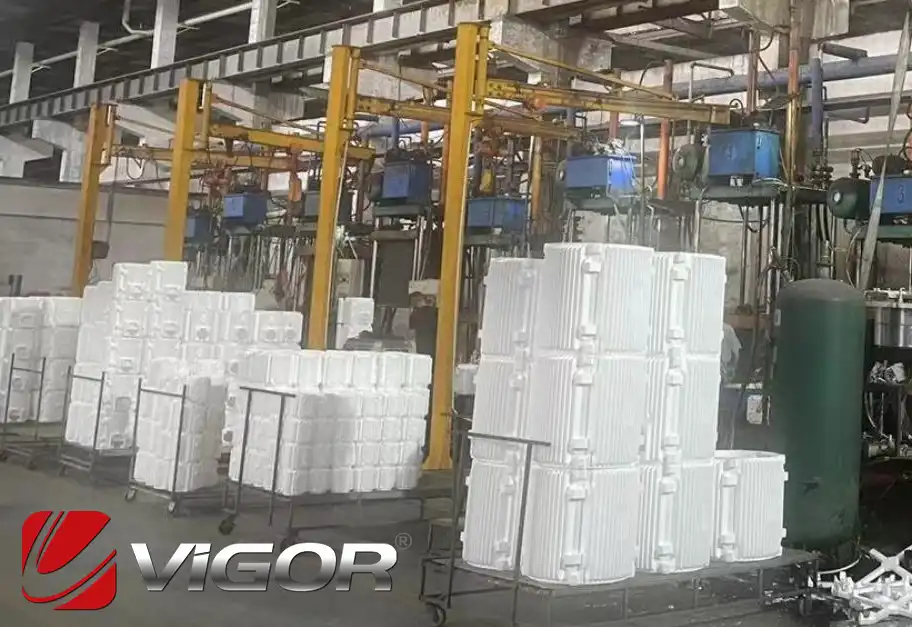
Knowledge
All About Lost-Foam Casting
Applications of Lost-Foam Casting
The primary uses of lost-foam casting are in the creation of parts with internal channels, thin walls, and delicate designs. The method excels in producing components like cylinder heads, engine blocks, and cooling system housings. Its capacity to perfectly reproduce intricate forms and details helps to produce high-quality and precisely engineered parts.
What Industries Use Lost-Foam Casting Products?
A wide range of industries, including: the automotive, marine, military, and agricultural fields, find use for lost-foam casting. It is a useful approach in creating components for these various sectors.
What Is the Quality of Lost-Foam Casting Products?
Lost-foam casting produces high-quality components with intricate details due to its ability to replicate complex shapes accurately. The durability of these products depends on factors such as: the chosen material, design considerations, and proper casting techniques. When executed with precision, lost-foam casting can yield durable and reliable products.
Are Lost-Foam Casting Products Heat Resistant?
Yes, products made with lost-foam casting can be heat resistant. The method is used to make heat-resistant components, especially those with elaborate designs and small sizes. It is often employed to make components that have strong heat-resistance qualities, which helps to make them suitable for a variety of applications.
What Are the Advantages of Lost-Foam Casting?
Listed below are the advantages of lost-foam casting:
l Excels in producing castings with high dimensional accuracy.
l Inherently avoids flash, the unwanted material accumulation on castings. The absence of a draft requirement ensures clean castings with impeccable dimensional accuracy.
l It's simpler than many other casting methods, involving fewer steps.
What Are the Disadvantages of Lost-Foam Casting?
Listed below are some disadvantages of lost-foam casting:
When closed-die molding is employed for pattern creation, the cost of the die can become a significant factor.
While patterns are lightweight and easy to handle, they are susceptible to damage and distortion. This requires careful handling throughout the process.
The presence of burnt polystyrene foam can lead to a higher degree of porosity in the castings. This can potentially affect their structural integrity and quality.
Is Lost-Foam Casting Expensive?
Yes, lost-foam casting is more expensive than other techniques. But, it has the advantage of having tighter tolerances, being lighter, and having features that are as-cast, which cut down on machining and cleanup time. It is possible to cast a large number of components that need milling, turning, drilling, and grinding with a small amount of machine stock.
Is Lost-Foam Casting the Same as Investment Casting?
No, lost-foam casting and investment casting are not the same thing. While lost-foam and investment casting are similar, the latter uses wax patterns while the former uses expanding polystyrene foam. The selection of pattern material distinguishes the two methods even though they are fundamentally similar.
What Is the Difference Between Lost-Foam Casting and Sand Casting?
Lost-foam casting and sand casting are distinct techniques employed in metal casting. Lost-foam casting excels in detailed, high-surface finish parts, while sand casting's versatility lies in larger components. While both yield metal parts, they differ significantly in their processes, complexity, costs, and the part types they cater to. Table 1 below lists their differences in more detail:
|
|
Lost-Foam Casting |
Sand Casting |
|
Process |
Molds are made from foam designs coated with refractory material, which are then vaporized by molten metal to form the component. |
Compacted sand molds capture patterns to define part shape, with sand removed after solidification. |
|
Complexity |
Facilitates intricate, detailed, and complex parts with ease. |
Better suited for simpler, larger parts due to molding limitations. |
|
Surface Finish and Tolerance |
Yields smooth surface finish and precise dimensions. |
Typically results in rougher surfaces and looser tolerances. |
|
Cost and Tooling |
Foam pattern cost offset by avoiding complex molds; higher upfront cost. |
More cost-effective for low to medium volumes; cheaper pattern materials. |
|
Part Size and Weight |
Adaptable for both small and large parts. |
Suited for larger components, particularly in heavy machinery. |
Vigor is a reputable manufacturer of machinery and equipment that offers an extensive range of casting processes customized to your unique product specifications. We meticulously craft every product to cater to your specific requirements, ensuring that the end result meets your exact needs.
Our commitment to quality extends beyond production, as we conduct comprehensive 100% testing upon completion to ensure that our products meet the highest standards of quality and adhere to industry regulations. With Vigor, you can trust that your product is ready to perform at its best from the moment it's delivered.
At Vigor, we understand that time is critical in the manufacturing industry. That's why we prioritize efficient service and timely delivery without sacrificing the quality of our products or technical support. Our team of experts is always available to assist you with technical service, advice, and solutions tailored to your needs.
If you're considering Vigor's machinery and equipment solutions, don't hesitate to contact us. We offer top-notch technical support and the highest-quality products available, all backed by our commitment to customer satisfaction. Trust Vigor to be your partner for excellence in machinery and equipment manufacturing.




